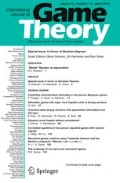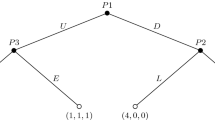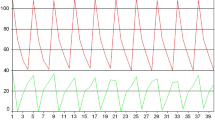Abstract
A product set of strategies is a p-best response set if for each agent it contains all best responses to any distribution placing at least probability p on his opponents’ profiles belonging to the product set. A p-best response set is minimal if it does not properly contain another p-best response set. We study a perturbed joint fictitious play process with bounded memory and sample and a perturbed independent fictitious play process as in Young (Econometrica 61:57–84, 1993). We show that in n-person games only strategies contained in the unique minimal p-best response set can be selected in the long run by both types of processes provided that the rate of perturbations and p are sufficiently low. For each process, an explicit bound of p is given and we analyze how this critical value evolves when n increases. Our results are robust to the degree of incompleteness of sampling relative to memory.
Similar content being viewed by others
References
Basu K, Weibull JW (1991) Strategy subsets closed under rational behavior. Econ Lett 36: 141–146
Ellison G (2000) Basins of attraction, long-run stochastic stability, and the speed of step-by-step evolution. Rev Econ Stud 67: 17–45
Harsanyi JC, Selten R (1988) A general theory of equilibrium selection in games. MIT Press Books, Cambridge, MA
Hurkens S (1995) Learning by forgetful players. Games Econ Behav 11: 304–329
Kajii A, Morris S (1997) The robustness of equilibria to incomplete information. Econometrica 65: 1283–1309
Klimm M, Sandholm T, Weibull JW (2010) Finding all minimal sCURB sets in finite games. Working Paper, Stockholm School of Economics
Kojima F, Takahashi S (2008) p-Dominance and perfect foresight dynamics. J Econ Behav Organ 67: 689–701
Maruta T (1997) On the relationship between risk-dominance and stochastic stability. Games Econ Behav 19: 221–234
Matsui A, Matsuyama K (1995) An approach to equilibrium selection. J Econ Theory 65: 415–434
Monderer D, Sela A (1997) Fictitious play and no-cycling conditions. Working Paper, The Technion
Morris S, Rob R, Shin HS (1995) p-Dominance and belief potential. Econometrica 63: 145–157
Morris S, Ui T (2005) Generalized potentials and robust sets of equilibria. J Econ Theory 124: 45–78
Oyama D, Takahashi S, Hofbauer J (2008) Monotone methods for equilibrium selection under perfect foresight dynamics. Theor Econ 3: 155–192
Tercieux O (2006a) p-Best response set. J Econ Theory 131: 45–70
Tercieux O (2006b) p-Best response sets and the robustness of equilibria to incomplete information. Games Econ Behav 56: 371–384
Young HP (1993) The evolution of conventions. Econometrica 61: 57–84
Young HP (1998) Individual strategy and social structure. An evolutionary theory of institutions. Princeton University Press, Princeton
Author information
Authors and Affiliations
Corresponding author
Rights and permissions
About this article
Cite this article
Durieu, J., Solal, P. & Tercieux, O. Adaptive learning and p-best response sets. Int J Game Theory 40, 735–747 (2011). https://doi.org/10.1007/s00182-010-0266-2
Accepted:
Published:
Issue Date:
DOI: https://doi.org/10.1007/s00182-010-0266-2




